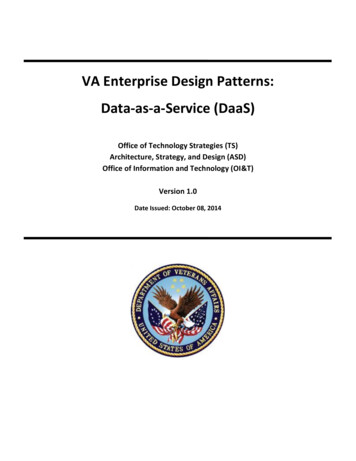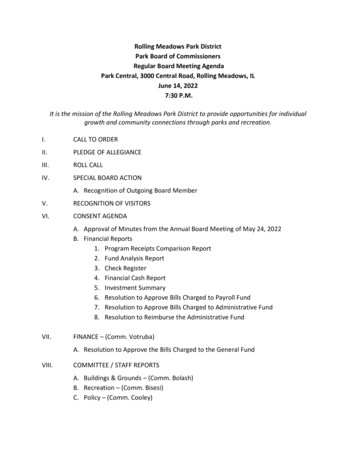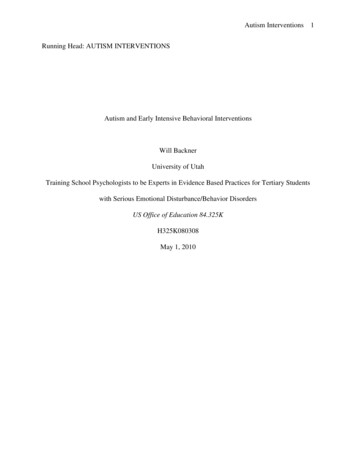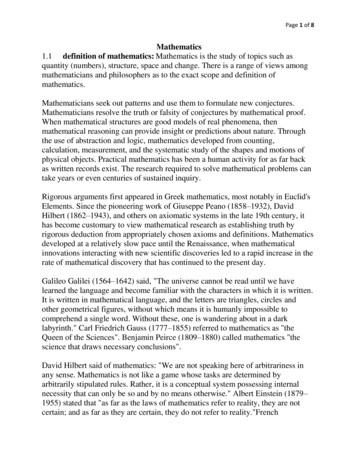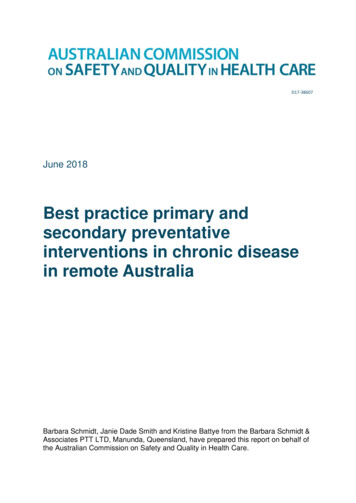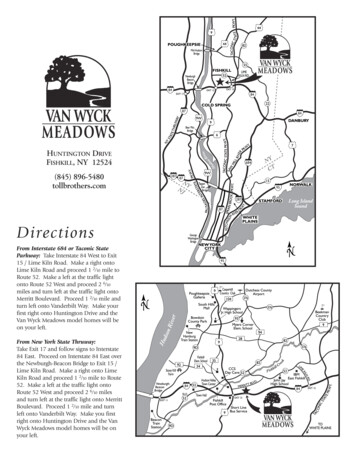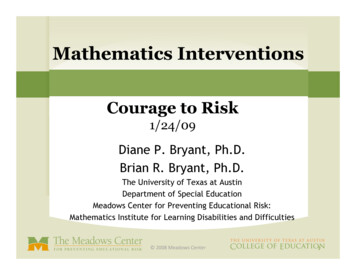
Transcription
Mathematics InterventionsCourage to Risk1/24/09Diane P. Bryant, Ph.D.Brian R. Bryant, Ph.D.The University of Texas at AustinDepartment of Special EducationMeadows Center for Preventing Educational Risk:Mathematics Institute for Learning Disabilities and Difficulties 2008 Meadows Center1
Advance Organizer Mathematics Education and a 3-Tier Model Mathematics Difficulties Tier 2 Intervention Booster Lessons 2008 Meadows Center2
Warm-up Count by 10’s, 5’s, 2’s Count up/back (from a given point) Write your numbers (10 . . . . ) Answer facts 2008 Meadows Center3
7 5 6 6 9 4 9 9 7 6 8 3 8 7 9 2 2008 Meadows Center4
2008 Meadows Center5
Mathematics Education and a 3-Tier Model 2008 Meadows Center6
www.cde.state.co.us/RtI/LearnAboutRtI.htm 2008 Meadows Center7
Mathematics EducationProblem SolvingUnderstanding/ApplicationNumber SenseBasic SkillsKnowledge/UnderstandingKnowledge/Application 2008 Meadows Center8
NCTM Curriculum Focal Points & Connections,Sept. indergarten:Number & Operations: Representing, comparing, and ordering whole numbersand joining and separating sets (Geometry, Measurement)First Grade:Number & Operations & Algebra: Developing understanding of addition &subtraction and strategies for basic addition facts and related subtraction factsNumber & Operations: Developing an understanding of whole numberrelationships including grouping in tens & ones (Geometry)Second Grade:Number & Operations: Developing an understanding of the base-ten numerationsystem and place-value conceptsNumber & Operations & Algebra: Developing quick recall of addition facts andrelated subtraction facts & fluency with multidigit addition and subtraction(Measurement) 2008 Meadows Center9
Number Sense NCTM described number sense as “moving from theinitial development of basic counting techniques tomore sophisticated understandings of the size ofnumbers, number relationships, patterns, operations,and place value” (2000, p.79). . . . good number sense abilities as movingeffortlessly between quantities and number (Case, 1998). . . . . represent numbers in many ways, recognizenumerical patterns [algebraic reasoning], andunderstand numerical quantities 2008 Meadows Center10
Number Sense A strong relationship between number senseabilities and mathematics achievement hasbeen found in the primary grades (Jordan, Kaplan, Oláh, &Locuniak, 2006; Locuniak & Jordan, 2008). Examples of skills that are related to numbersense include counting, quantity comparison(Which group has more? Which number isgreater?), arithmetic facts, and storyproblems Bryant et al., 2008). 2008 Meadows Center11
What does it take . . . . . To use the count-on strategy to add 9 3 ? To use the doubles 1 strategy? To identify where to put the number 50 on a numberline? To use a hundreds chart to count by 10s beginningwith 32? To use the decomposition strategy to add 9 4 ? To identify which number is greater: 49 or 62? To tell which number comes before 21? To subtract two numbers that require regrouping? 2008 Meadows Center12
What does it take . . . . . To use the count-on strategy to add 9 3 ?(recognize 1, 2, 3 are count on strategies; min strategy: bigger # inhead [9] count on 3 [keeping track of 3 while also countingconsecutively - tap fingers, hold up fingers]To use the doubles 1 strategy?(Doubles, know doubles 1 two numbers next to each otheron the number line) To identify where to put the number 50 on a number line?(recognize start & end point; distance between; where 50belongs) To use a hundreds chart to count by 10s beginning with 32?(start with 32, recognize 42 is 10 more) 2008 Meadows Center13
To use the decomposition strategy to add 9 4 ?(9 1 and 4 3 1, use the 1 to make 10, now 10 3 13). To identify which number is greater: 49 or 62? 68 or 61?(start with 10s; go to ones) To tell which number comes before 21?(vocabulary: before, 20) To subtract two numbers that require regrouping?(understands place value, checks ones place, knows top numbershould be bigger, subtracts-knows facts) 2008 Meadows Center14
Mathematics Difficulties 2008 Meadows Center15
What do we know about characteristics ofstudents with math difficulties?Procedural Difficulties- Inefficient/ineffective strategy use - Errors in math problemexecution (following the steps to solve the problem) - Doesn’tuse knowledge of propertiesFails to verify answers and settles for first answerTakes a long time to complete calculationsMakes "borrowing" (i.e., regrouping, renaming) errorsCounts on fingersCalculates poorly when the order of digit presentation is alteredDisregards decimalsFails to carry (i.e., regroup) numbers when appropriate(Bryant, Bryant, & Hammill, 2000; Geary, 2004) 2008 Meadows Center16
What do we know about characteristics ofstudents with math difficulties?Representative Memory Problems-Poor long-term memory retrieval skills (permanent storage of informationthat is assisted by how information is stored) - Working memory deficits(processing and storing information simultaneously)Cannot recall number facts automatically (declarative knowledge)Cannot remember procedural stepsRepresentative Visual/spatial Deficits-Weak visual/spatial representations-Orders and spaces numbers inaccurately in multiplication and divisionMisaligns vertical numbers in columnsProblems with place value that involves understanding base ten systemTrouble interpreting maps and understanding2008 Meadows Center geometry17
What do we know about characteristicsof students with math difficulties?Problems with Number SenseNumber magnitude comparison confusionPoor number naming and writingUnderstanding relative size of parts such as thirds, tenths,25% and their relationship to a whole unitFails to see "unreasonable" answersDisregards decimalsFails to read accurately the correct value of multi-digitnumbers because of their order and spacing 2008 Meadows Center18
Problem Areas in children with MD,MD/RD and RD only*K, 1, 2, 3( problem - not a problem)SkillCountingMD only MD/RD RD/only-Number Knowledge -Rapid Fact Retrieval -Number Naming -Problem Solving- -Reliance on Fingers -Digit Span- -Word Articulation Speed - *From: Jordan, N.C. (2007). Do words count? Compilation of results from several studies.“D” refers to difficulties. 2008 Meadows Center19
Early Predictors of MathAchievement*TaskAreas AssessedCounting skillsSet enumeration; rote counting; 1-1correspondence; stable order; cardinalityNumber knowledge Relationships between numbers(e.g., magnitude comparisons)Nonverbal calculation:Set transformations Adding or taking away objects hidden under abox(“How many objects under the box?”).Story problemsSingle-digit addition and subtractionproblems embedded in storiesNumber comboSingle-digit addition and subtractionproblems (“How much is 2 1?)*From: Jordan, N.C. (2007). Do words count? Compilation of results from several studies. 2008 Meadows Center20
Tier 2 Intervention Booster Lessons 2008 Meadows Center21
Tier 2 Types of Boosters ConcreteRepresentation Visual/PictorialSkillRepresentationBuilding/ Abstract/Numeric TEKSCR/VR/ARLowerFluencyBuildingProficiency Levels 2008 Meadows CenterHigher22
What content is important for Tier 2based on the research?Word Problem Solving: types of problems, extraneousinformation, multiple steps, contextualizedNumber Knowledge and RelationshipsCounting: Rote, Rational, Counting Up/Back, Skip (2, 5, 10)Number Recognition & Writing: 0 – 99 (1st); 0 – 999 (2nd grade)Comparing & Grouping NumbersNumber Relationships of more, less,Relationships of one and two more than/less thanAnchoring Numbers to 5 & 10 framesPart-part-whole Relationships (e.g., ways to representnumbers)Numeric Sequencing 2008 Meadows Center23
What content is important for Tier 2based on the research?Base 10 & Place ValueMaking and counting: groups of tens and ones (1st grade); groups ofhundreds, tens, and ones (2nd grade)Using base-ten language (3 hundreds, 0 tens, 6 ones) and standardlanguage (306) to describe place valueReading and writing numbers to represent base ten modelsNaming the place value held by digits in numbersAddition & Subtraction CombinationsIdentity Element and PropertiesFact FamiliesCounting & Decomposition Strategies (e.g., Addition: count on[ 0, 1, 2], doubles, doubles 1, make 10 more;Subtraction:count down [-0, -1, -2, -3], count on 2008 Meadows Center24
Procedures & Features of Tier 2Intervention* Groupings: homogeneous grouping with 3 - 5 students per group Duration: 4 times per week for 25 minutes; PM 5th day Lesson Design: mixed (instructional content-IC), scaffolded,scripted interventions; explicit, strategic, “think aloud;” errorcorrection; factual, procedural, and strategic learning Instructional Content: IC ranges focusing on difficult numbers;vocabulary; (e.g., greater than/less than); number, operation,quantitative reasoning; patterns/relationships/algebraic thinking;problem solving; other TEKS (implicit)*Based on Research for Students with Difficulties/Disabilities 2008 Meadows Center25
Procedures & Features of Tier 2Intervention Representations: physical (concrete), visual (pictorial),abstract (numbers/symbols) Materials: number charts (100s), 5- and 10-frames, counters,cubes, number lines, base-ten materials, dot cards, fact cards,place value cards Progress monitoring: daily checks (independent practice); aimchecks Stretch Your Skills Bubble answers Fidelity Checks 2008 Meadows Center26
Sample Fidelity of Implementation Rating Scale 2008 Meadows Center27
Instructional Routine for Tier 2Intervention Booster Lessons*Framing the lessonPreviewingModeling w/think alouds or ModeledPracticeGuided practiceIndependent practiceChecking for understandingError correction and feedbackProgress monitoring*Based on Research for Students with Difficulties/Disabilities* 2005 Psycho-Educational2008 MeadowsServicesCenter28
What we know. . . . . Multiple opportunities to practice within thelessons Good pacing Error correction Opportunities to make, show, write numberconcepts; problem solving Regular, consistent intervention 4-5 daysper week Strategies to procedural knowledge Progress Monitoring/Data*Based on Research for Students with Difficulties/Disabilities* 2005 Psycho-Educational2008 MeadowsServicesCenter29
You can create yourintervention to include . . . . .1. Warm-up: 2 minutes, previous facts,number recognition, number writingLook & Say or Look & Write2. Specific strategies for facts: minstrategy (bigger number ); factfamilies /-1, /-2, /-3; doubles;doubles 1; harder facts(decomposition 10)*Based on Research for Students with Difficulties/Disabilities* 2005 Psycho-Educational2008 MeadowsServicesCenter30
You can create yourintervention to include . . . . .3.Place Value: C-P-A; Language: Howmany groups? How many altogether?10, 20, 30, switch; place value mat4. Ordering and comparing numbers:connect to place value, omitbeginning number mostly ( , 16,17; , 203, 204); greater than/lessthan-start with tens or hundredsplace if same go to next place*Based on Research for Students with Difficulties/Disabilities* 2005 Psycho-Educational2008 MeadowsServicesCenter31
You can create yourintervention to include . . . . .5.Cool down: more facts-Look & Sayand Look & Write6. Application: games, Stretch YourSkills*Based on Research for Students with Difficulties/Disabilities* 2005 Psycho-Educational2008 MeadowsServicesCenter32
Daily Activity Check Progress Monitoring- First and Second GradeUnit:StudentTutor:Time8/26/22Day 2Date:PV:MC:FF:5/27/22/2Group:Day 7/22/2Day 1Date:ASC:WPS:NS:5/27/22/2Time8/26/22Time :Day S:8/26/22PV:MC:FF:TimeBehavior: 2008 Meadows Center33
Graphing Unit ChecksFrom: Bryant, B. R., & Bryant, D. P. (2008).Monitoring progress to determine RtI. Manuscriptin preparation. 2008 Meadows Center34
Student 2 Progress Monitoring Data 2008 Meadows Center35
Validating the Interventions:Results Tier 2 Intervention 2007-2008 [3-Tier Schools]: Based on Spring TEMI-PM results withbelow the 25th percentile as the cut score for Tier 2 Kindergarten: 41% qualified to exit Tier 2 25% qualified for Tier 2 34% qualified for Tier 3 (below the 10th percentile) First Grade: 52% qualified to exit Tier 2 24% qualified for Tier 2 24% qualified for Tier 3 Second Grade: 49% qualified to exit Tier 2 24% qualified for Tier 2 27% qualified for Tier 3 2008 Meadows Center36
Tier 3: Tertiary Intensive Intervention:Essential Features Instructional Explicitness Instructional Design to Minimize the Learning Challenge Conceptual Basis Drill & Practice Cumulative Review Motivators to Monitor/Regulate Attention & Behavior Progress MonitoringFuchs et al. upcoming special series in LDQ 2008 Meadows Center37
What Works Clearinghouse WWC Evidence Standards: identify studies that provide the strongest evidence of effects randomized controlled trials and regression discontinuitystudies, and secondarily quasi-experimental studies ofespecially strong design "Meets Evidence Standards” "Meets Evidence Standards with Reservations” "Does Not Meet Evidence .gov/ncee/wwc/reports/topic.aspx?tid 04 (reports) 2008 Meadows Center38
WWC: Under Review Programs under review Accelerated MathBridges in MathematicsCompass Learning OdysseyInvestigations in Number, Data, and SpaceKumon Mathematics Program 2008 Meadows Center39
The Access Center http://www.k8accesscenter.org/training resources/math.asp Mathematics Strategy Instruction (SI) for Middle SchoolStudents with Learning Disabilities Using Mnemonic Instruction to Teach Math Using Peer Tutoring for Math Computer-Assisted Instruction and Math Direct/Explicit Instruction and Math Learning Strategies and Math Concrete-Representational-Abstract InstructionalApproach Learner Accommodations and InstructionalModifications for Students with LearningDisabilities 2008 Meadows Center40
More Resources Math Differentiation Brief Math Graphic Organizers Math Problem Solving for Primary ElementaryStudents with Disabilities Math Problem Solving for Upper ElementaryStudents with Disabilities Illuminationshttp://illuminations.nctm.org/ MathToolshttp://www.mathforum.org/mathtools/ Meadows Center for Preventing Educational Risk: MathematicsInstitute for Learning Disabilities and Difficultieshttp://www.meadowscenter.org/ www.earlymathintervention.org 2008 Meadows Center41
Sample LessonsLets look at some sample lessons. 2008 Meadows Center42
2008 Meadows Center 14 To use the decomposition strategy to add 9 4 ? (9 1 and 4 3 1, use the 1 to make 10, now 10 3 13). To identify which number is greater: 49 or 62? 68 or 61? (start with 10s; go to ones) To tell which number comes before 21? (vocabulary: before, 20) To subtract two numbers that require regrouping?


